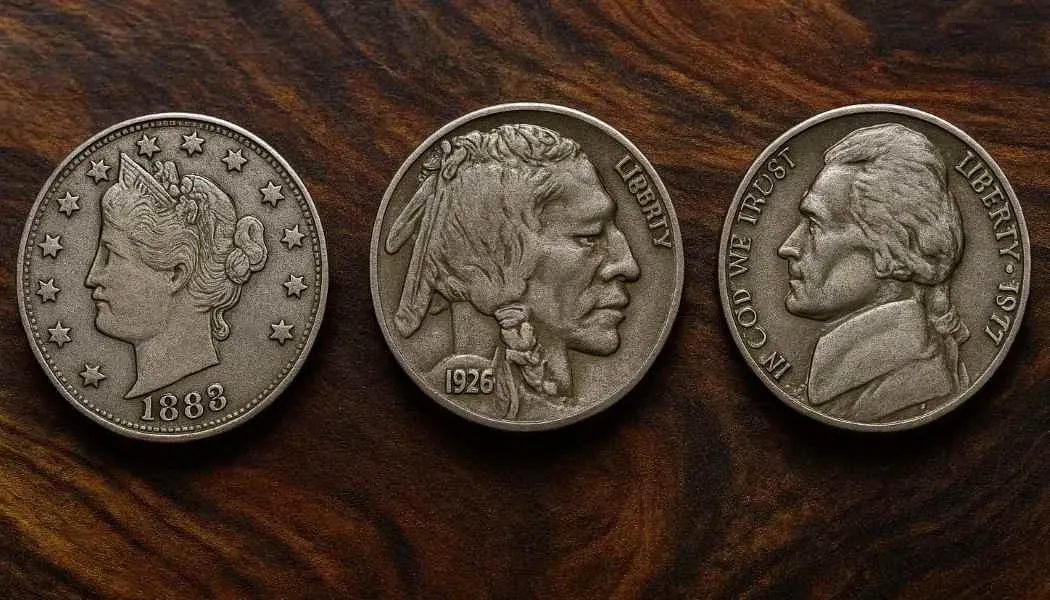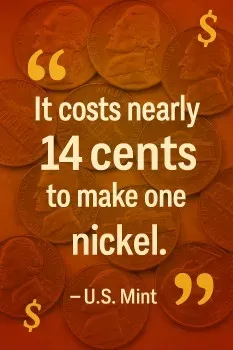
The Five-Cent Coin Faces a Costly Future
With the U.S. Mint officially winding down penny production in 2025, questions are swirling about the future of the nickel - a coin that's now facing serious scrutiny. Once a go-to denomination in coin-operated machines and everyday change, the nickel now costs almost 14 cents to manufacture, creating a financial burden that lawmakers are finally addressing.
Earlier this year, H.R.1270, a bipartisan bill, proposed a temporary halt to the minting of both pennies and nickels. The goal? Conduct a comprehensive review of their long-term economic viability. While nothing about the nickel is set in stone yet, the message is clear: low-value coins may soon be history.
As collectors and investors take notice, the U.S. nickel is being reevaluated - not just as small change, but as a piece of history and potential treasure.
The U.S. Nickel Through the Decades: A Legacy of Design
Since its debut in the 1860s, the nickel has undergone a fascinating evolution. Here’s a snapshot of the major design eras that define its collectible journey:
- 1866–1883: Shield Nickel – The very first five-cent piece made with a copper-nickel alloy. No denomination marked initially - leading to fraudulent misuse.
- 1883–1913: Liberty Head “V” Nickel – Classical design featuring Lady Liberty and a large Roman numeral “V” on the reverse.
- 1913–1938: Buffalo Nickel – Iconic Native American and bison imagery that has become an American classic.
- 1938–2003: Jefferson Nickel (Original) – Introduced with Jefferson's portrait and Monticello on the reverse, designed by Felix Schlag.
- 2004–2005: Westward Journey Series – Celebrated the Lewis and Clark expedition with bold, modern imagery.
- 2006–Present: Updated Jefferson Nickel – A forward-facing Jefferson modernized for contemporary minting.
For collectors, these changes offer over 150 years of variation, historical value, and investment potential - especially if the series is nearing its end.
Can the Nickel Be Redesigned Instead of Retired?
Before pulling the plug entirely, legislators and mint officials are weighing possible alternatives that could save the nickel without draining the federal budget:
Change the Composition
By using cheaper metals like steel or zinc plating, instead of copper-nickel, the Mint could slash production costs while preserving the coin's basic function - similar to changes made in Canadian coinage.
Shrink the Size and Weight
A redesigned, smaller nickel could reduce raw material needs while still working in vending machines and coin sorters. Compact, cost-effective, and familiar.
Limit Circulation
Rather than mass-producing the coin, the Mint could limit the nickel’s use to collector sets, commemorative issues, or small-circulation mintages.
Pilot Programs & Public Testing
H.R.1270 may pave the way for new experimental programs to test alternate materials, sizes, and public reception before a full transition occurs.
Even if it disappears from daily transactions, the nickel’s role in American currency could transform rather than vanish.
Top 20 Most Valuable and Collectible U.S. Nickels
Whether you’re a seasoned collector or just getting started, these are the top U.S. nickels to hunt down before the coin potentially vanishes:
- 1913 Liberty Head Nickel – Only 5 known. One sold for over $4 million.
- 1885 Liberty Head Nickel – Lowest mintage of the V series. Scarce and prized.
- 1926-S Buffalo Nickel – Lowest mintage of the Buffalo run. Rare in high grade.
- 1918/7-D Buffalo Nickel – Overdate error. Hard to find, even harder to afford.
- 1937-D “Three-Legged” Buffalo Nickel – Striking mint error. Widely collected.
- 1942-P War Nickel – First with 35% silver and large “P” mintmark.
- 1943-P Double Eye Jefferson Nickel – Striking double die variety.
- 1950-D Jefferson Nickel – Lowest mintage of the Jefferson series.
- 1939-D Jefferson Nickel – Weak strikes and limited supply in high grades.
- 1964 SMS Jefferson Nickel – Special strike shrouded in mystery. Valuable in high quality.
- 2005-D Speared Bison Nickel – Modern error with strong collector demand.
- 2009-P Jefferson Nickel – Low mintage. Still flying under the radar.
- 1938-D Buffalo Nickel – Final year of the Buffalo design. Undervalued in MS.
- 1867 Shield Nickel with Rays – Briefly issued. More desirable than no-ray version.
- 1877 Shield Nickel – Another ultra-low mintage entry.
- 1949-D/S Overmintmark Jefferson Nickel – Rare and sought-after error.
- 1981-S Type 2 Proof Jefferson Nickel – Distinctive “S” mintmark in late run proofs.
- 2004-D Peace Medal Nickel – From the Westward Journey series; MS67 and higher bring premiums.
- 1982-P Jefferson Nickel (No Mintmark) – An oddity for Philadelphia coins.
- 1971-S Cameo Proof Jefferson Nickel – Popular among modern proof collectors.
Why Collectors Are Taking the Nickel Situation Seriously
While it may seem like pocket change today, the U.S. nickel has the potential to become one of the most collectible coins of the decade. Between low mintage varieties, striking design shifts, and mounting legislative pressure, the nickel’s trajectory is anything but ordinary.
The possible pause in production may just be the beginning of its exit - but for collectors, that makes now the perfect time to scoop up key dates, hunt through pocket change, or invest in certified high-grade examples.
At Bullion Hunters, we keep a close eye on the changing face of American coinage and offer smart insights into the coins worth watching - and owning.

